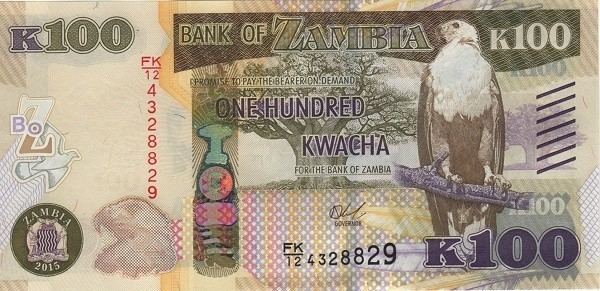⁄100 ngwee | Symbol ZK | |
 | ||
Code ZMWZMK until December 31, 2012 Freq. used 2, 5, 10, 20, 50, 100 kwacha Freq. used 5, 10, 50 ngwee and 1 kwacha | ||
The Kwacha (ISO 4217 code: ZMW) is the currency of Zambia. It is subdivided into 100 Ngwee.
Contents
Etymology
The name 'Kwacha' derives from the Nyanja word for "dawn", alluding to the Zambian nationalist slogan of a "new dawn of freedom". The name ngwee translates as "bright" in the Nyanja language.
History
Prior to independence, the Southern Rhodesian pound was the legal tender of the short-lived British protectorate of Northern Rhodesia. Banknotes of 10 shillings, 1, 5, and 10 pounds issued by the Central Africa Currency Board were in circulation, together with coins of ½, 1, 3, 6 pence, and 1, 2, 2½, and 5 shillings. After independence, the Bank of Zambia issued the first Zambian currency, the Zambian pound, in 1964. The issued paper bills and coins were of similar denominations as these used before independence, except for the 10 pounds note, which was never issued by the Bank of Zambia. A new design to depict the newly independent country's history and struggle was adopted. The two currencies - the South Rhodesian pound and the Zambian pound, were allowed to circulate in parallel until December 15, 1965, when the South Rhodesian pound bills and coins were withdrawn from circulation, except for the 3 pence coin which was allowed to circulate alongside its Zambian alternative for a brief period.
On July 1, 1966, the parliament approved the arrangements of th decimal currency system (Act 40 of 1966). The government voted in favor of decimalisation, and changing the main currency unit to Kwacha, with one kwacha being equal to 100 ngwee. The exchange rate was set to one kwacha equivalent to ten Zambian shillings, or one half of a Zambian pound. Thus, by January 16, 1968 all Zambian pound bills and coins were removed from circulation and replaced by the new kwacha bills, and ngwee coins. The Zambian pound bills of 10 shillings, 1, and 5 pounds were changed into 1, 2 and 10 kwacha respectively, a bill of 50 ngwee was issued to replace the old 5 shillings coin, alongside a new bill of 20 kwacha. Ngwee coins with the denominations of 1, 2, 5, 10, and 20 ngwee replacing the existing 1, 3, 6 pence, 1, and 2 shillings coins respectively. The Zambian pound notes, and coins ceased to be a legal tender on January 31, 1974.
At the very beginning, the kwasha was pegged to the pound at a fixed rate of 1.7094 kwacha per 1 pound. Yet, after the devaluation of the dollar on August 15, 1971, Zambia broke all its currency's ties to the British monetary unit, and pegged the kwacha to the American monetary unit. These reforms resulted in a reduction of the kwacha's gold standard by 7.8%. A few months later, the British Chancellor of the Exchequer Anthony Barber, announced the demise of the Sterling area, and floatation of the sterling pound, causing Zambia to renounce the monetary privileges once enjoyed as a member state.
Throughout the years, the Zambian currency suffered high rates of inflation forcing the Bank of Zambia to introduce high value denominations in 2003, including 20,000 and 50,000 kwacha bills to facilitate transactions. In 2013, a new, redenominated kwacha was introduced.
Coins
In 1968, bronze 1 and 2 ngwee and cupro-nickel 5, 10 and 20 ngwee were introduced. These coins all depicted president Kenneth Kaunda on the obverse and flora and fauna on the reverse. A twelve sided 50 ngwee coin was introduced in 1979 to replace the 50 ngwee note and featured commemorative FAO themes.
(click for image).
In 1982, copper-clad-steel replaced bronze in the 1 and 2 ngwee. These two were struck until 1983, with production of the 5 and 10 ngwee ceasing in 1987 and that of the 20 ngwee in 1988. Nickel-brass 1 kwacha coins were introduced in 1989 and depicted "Bank of Zambia" on the edges. The period of circulation for this coin was brief as inflation rates skyrocketed.
In 1992, a new, smaller coinage was introduced consisting of nickel-plated-steel 25 and 50 ngwee and brass 1, 5 and 10 kwacha. The coins depict the national crest on the obverse and native fauna on the reverse. The coins were issued only one year and then discontinued as the economic crisis dragged on.
All these coins, both from the older and newer series still remain legal tender. However, the value of the metal in the coins is worth more than their irrelevant face value, so they are never seen or used in normal trade. The only place coins might be seen today is when they are sold as souvenirs to tourists.
On January 1, 2013 new coins were introduced, namely for 5, 10, 50 ngwee and 1 kwacha.
Coins of the new kwacha (2013 series)
